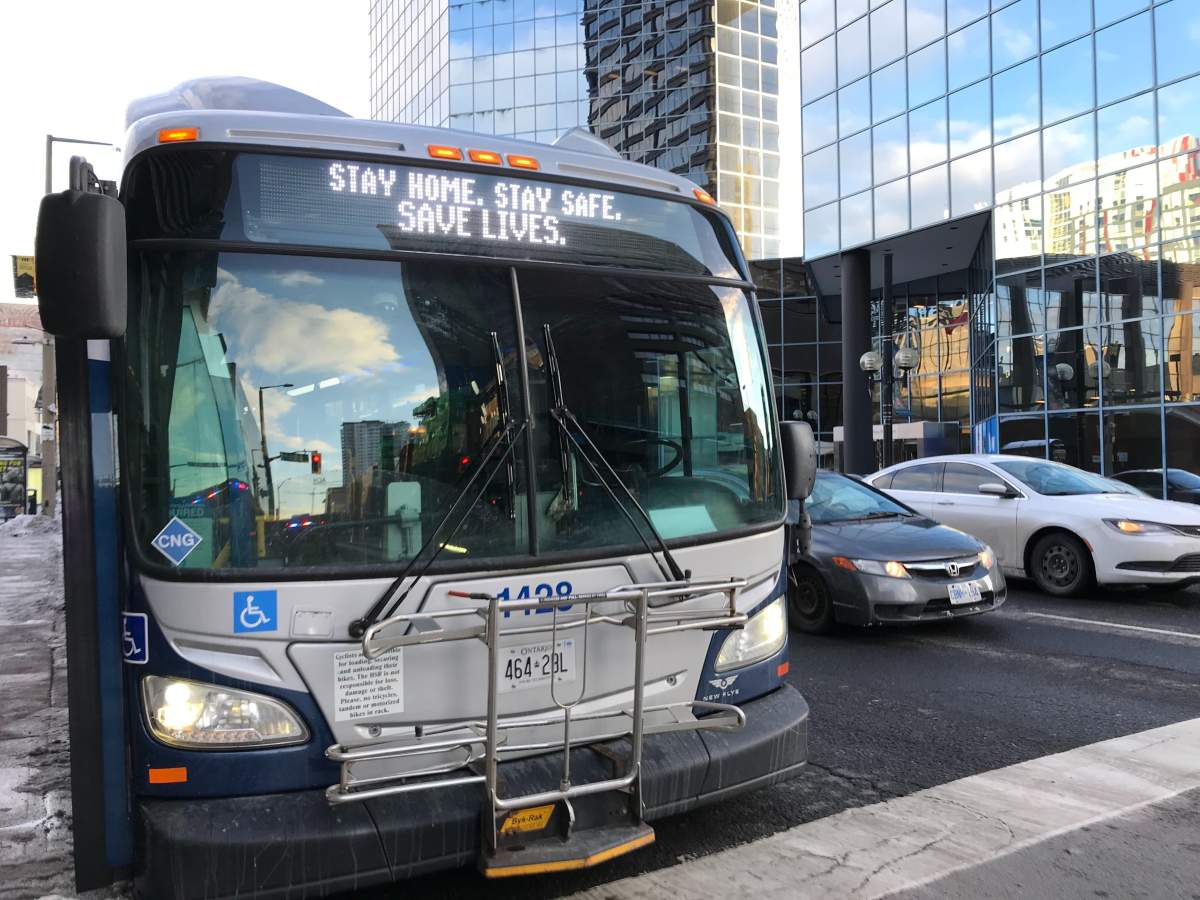Hamilton bus drivers are joining calls from across the country to increase safety measures on transit and prioritize transit drivers for the COVID-19 vaccine.

On Thursday, the Amalgamated Transit Union (ATU) of Canada held a news conference to call for increased protections for workers amid escalating outbreaks in transit settings and infections among drivers.
“We are standing with our members who continue to refuse unsafe working conditions,” said union president John Di Nino. “Our health and safety is non-negotiable.”
Eric Tuck, president of ATU Local 107 in Hamilton, said the union is asking the city to re-introduce safety measures on Hamilton Street Railway (HSR) buses that were in place early last year, like passenger boarding from the rear door and reducing capacity limits on buses to 25 per cent.
Currently, HSR buses are operating at a 50-per cent passenger capacity limit, but Tuck said that still means as many as 30 people could be riding a 40-foot bus.
“The first wave, we took all these precautions, and now we’re into the third wave, and it’s the worst that we’ve ever seen. Why are we not putting those precautions back in place?”
Tuck said they’re also asking for the mandatory mask policy to be absolute, with no exemptions.
“Our passengers get off a Barton bus with no mask, saying that they can’t wear it for medical reasons and then they walk over to the liquor store — you can watch them from the bus stop — they put a mask on because they won’t allow them into the liquor store without a mask. It’s ridiculous.”

Get daily National news
He said he’s supportive of drivers who refuse to pick up passengers that don’t wear masks.
“I told my members, you have to put your safety first. You’re responsible for your safety.”
Despite the call, the director of Hamilton’s emergency operations centre (EOC) isn’t promising any immediate changes to the existing rules and requirements for riding the bus.
“We are looking at this day by day and should things change and we feel we need to take any steps, whatever they might be, we won’t hesitate to do that,” said Paul Johnson.
He said it’s difficult to balance the need to ensure buses are safe for both passengers and drivers with the individual rights of people with medical exemptions to be able to access the transit system.
“If we pass somebody by because they didn’t have a mask on, but had an exemption for why they couldn’t wear a mask, and they were on their way to an essential doctor’s appointment or to do something … then we run into challenges with that. So it’s a balancing act of everyone’s safety, but everybody’s access to an essential service like transit.”
If the EOC determines that the risk of the highly transmissible variants means additional measures are needed on city buses, Johnson said they would consider options like introducing further restrictions or adding more buses to busier routes.
The ATU is also calling for transit drivers to be prioritized for the COVID-19 as essential workers in the community.
Johnson said that’s difficult at this point, saying there are roughly 300,000 Hamiltonians who fall into the ‘essential worker’ category and it will take several months to get through everyone.
He said it’s just a matter of a lack of supply right now.
“Not so much our readiness or our desire to really make sure that essential workers in a variety of categories have access to that vaccine very quickly, and transit workers would be right in that mix. They are one of many groups who we really feel need it as quickly as possible … but again, supply is our challenge.”
To date, the HSR has seen fewer cases of COVID-19 among its drivers compared to other municipalities, with Tuck reporting 15 cases among Hamilton bus drivers.
During Thursday’s press conference, the ATU reported over 800 cases within the Toronto Transit Commission (TTC), plus a 10-per cent infection rate in both Barrie and Brantford and outbreaks in the Ottawa and London transit systems.




_848x480_1397405763961.jpg?h=article-hero-560-keepratio&w=article-hero-small-keepratio&crop=1&quality=70&strip=all)



Comments